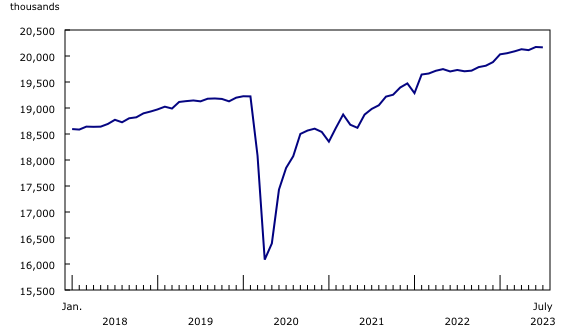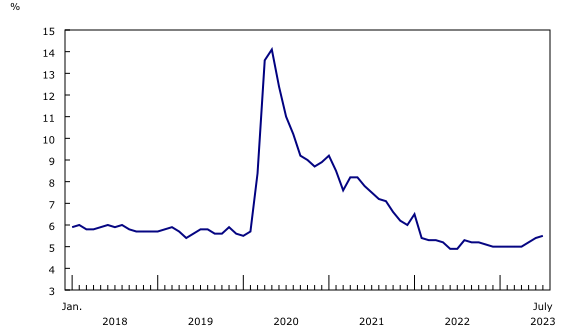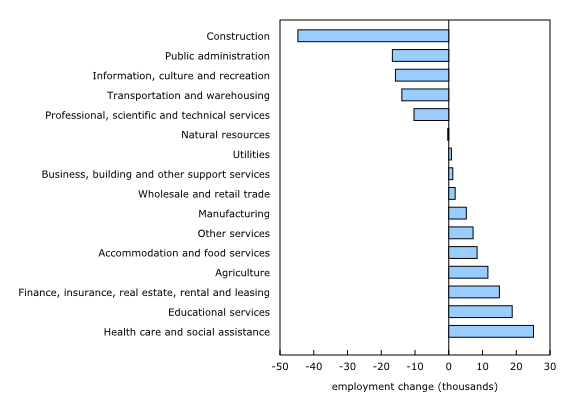The prospects for Canadians in the job market is looking very good since the Covid-19 pandemic is subsiding. Employment was little changed in July (-6,000; -0.0%). The unemployment rate increased 0.1 percentage points to 5.5%, marking the third consecutive monthly increase.

Employment fell among core-aged men aged 25 to 54 years old (-27,000; -0.4%) and increased among male youth aged 15 to 24 (+13,000; +0.9%). There was little variation in employment among young and core-aged women, and among men and women aged 55 and older.
There were fewer people employed in construction (-45,000; -2.8%), public administration (-17,000; -1.4%), information, culture and recreation (-16,000; -1.8%) as well as in transportation and warehousing (-14,000; -1.3%). Employment rose in health care and social assistance (+25,000; +0.9%), educational services (+19,000; +1.3%), finance, insurance, real estate, rental and leasing (+15,000; +1.1%) and agriculture (+12,000; +4.6%).
Employment increased in Alberta (+12,000; +0.5%), New Brunswick (+4,200; +1.1%) and Prince Edward Island (+1,500; +1.7%), while it declined in Manitoba (-6,400; -0.9%) and Saskatchewan (-5,700; -1.0%). All other provinces posted little change in July.
On a year-over-year basis, average hourly wages rose 5.0% in July, following increases of 4.2% in June and 5.1% in May.
Total hours worked were virtually unchanged in July and were up 2.1% on a year-over-year basis.
One-third of employed post-secondary students worked in a job closely related to their field of study in July.
Employment holds steady as population grows
Employment was virtually unchanged in July (-6,000; -0.0%), as the number of people working full-time and part-time held steady. From January to July, monthly employment growth has averaged 22,000.
The employment rate—the proportion of the population aged 15 and older who are employed—was 62.0% in July, down 0.2 percentage points in the month and little changed on a year-over-year basis. From January to July, the employment rate fell 0.5 percentage points, as population growth (+1.4%) outpaced growth in employment (+0.7%) over this period.
Employment declines among core-aged men and rises among young men
Among core-aged men (25 to 54 years old), employment fell by 27,000 (-0.4%) in July, partially offsetting cumulative gains of 92,000 from March to June. The employment rate for men in this age group was 87.6% in July, down 0.6 percentage points both from the previous month and from 12 months earlier.
Among core-aged women, employment was little changed in July and the employment rate fell 0.3 percentage points to 81.4%. After reaching a peak of 82.2% in January 2023, the employment rate of core-aged women has trended down.
In July, employment rose among young men aged 15 to 24 (+13,000; +0.9%), driven by gains in full-time work, and held steady among young women. The employment rate of young men (58.2%) was little changed in the month and was up 1.1 percentage points on a year-over-year basis. The employment rate for young women was 58.1% in July, little changed in the month but down 2.8 percentage points from 12 months earlier.
There was little change in the employment level for women and men aged 55 and older in July, and their employment rate held steady both in the month and on a year-over-year basis (40.3% for men and 30.7% for women in July). Recent data collected as part of a series of supplements to the Labour Force Survey (LFS) showed that the majority of older workers who were planning to retire would continue working longer if they could reduce hours and stress.
Employment rate among recent immigrants down year over year in July
Employment growth in the past year has occurred in the context of historically high population growth. A notable aspect of this population growth has been the contribution of record-high immigration levels.
In July, the employment rate of core-aged recent immigrants—those who had become landed immigrants in the previous five years—was 77.7%, down 2.3 percentage points from July 2022 (80.0%). In comparison, the employment rate of those born in Canada was 86.6% in July 2023, little changed from 12 months earlier (three-month moving averages; not seasonally adjusted).
Despite the year-over-year decline, the employment rate of core-aged recent immigrants in July 2023 remained higher than before the COVID-19 pandemic; the average rate in July for this group from 2017 to 2019 was 70.8%. Similarly, in July 2023, the employment rate for core-aged persons born in Canada was above the average rate for the same month from 2017 to 2019 (84.9%) (three-month moving averages; not seasonally adjusted).
Unemployment rate increases for third consecutive month
The unemployment rate rose 0.1 percentage points to 5.5% in July, following increases in May (+0.2 percentage points) and June (+0.2 percentage points). This was the first time the unemployment rate had increased for three consecutive months since the early months of the COVID-19 pandemic.
For female youth aged 15 to 24, the unemployment rate increased 1.5 percentage points from April to July to reach 10.3%. The unemployment rate also rose by 0.8 percentage points during this same period to 5.0% for core-aged women and by 0.8 percentage points to 4.3% for women aged 55 and older. At the same time, there was little change in the unemployment rate for men across the same age groups.
In July 2023, more than half of the unemployed (53.6%) had been out of the labour force (either unavailable or not searching for work) immediately prior to becoming unemployed, while 38.7% had left or lost a job. The remainder (7.7%) were on temporary lay-off or were waiting to start a new position. These proportions were little changed from a year earlier (not seasonally adjusted).
Wages up among both men and women
On a year-over-year basis, average hourly wages rose 5.0% (+$1.59 to $33.24) in July, following increases of 4.2% in June and 5.1% in May (not seasonally adjusted).
Wages grew at a similar pace for core-aged men (+5.0% to $38.72) and core-aged women (+5.0% to $33.98) over the 12-month period. Wages for all employees rose at a slightly faster rate for full-time employees (+5.2% to $34.95) than for those working part-time (+4.7% to $23.50).
Employment rate among female students down from the summer of 2022
From May to August, the LFS collects labour market data on youth aged 15 to 24 who were full-time students in March and who intend to return to school full time in September. The results are not seasonally adjusted.
The employment rate among female returning students aged 15 to 24 was 59.1% in July, down from a recent high for the month of July recorded in 2022 (62.8%). In comparison, the pre-pandemic average for the month of July from 2017 to 2019 was 60.7%.
The employment rate among male returning students aged 15 to 24 was 57.0% in July, up 1.8 percentage points from July 2022, and above the average of 53.7% for the month of July from 2017 to 2019.
Employment falls in four industries, led by construction, and increases in four others
In construction, employment decreased by 45,000 (-2.8%) in July, following a smaller decline of 14,000 (-0.8%) in June. Since January 2023, employment in construction decreased by 71,000, offsetting cumulative increases of 65,000 from September 2022 to January 2023. In July, the decline was concentrated in British Columbia (-21,000), Quebec (-11,000) and Ontario (-9,000).
Following four months of little change, the number of people working in public administration fell by 17,000 (-1.4%) in July. Compared with a year earlier, employment in public administration was up by 42,000 (+3.7%).
In July, employment in information, culture and recreation declined by 16,000 (-1.8%), marking the first monthly decrease in the industry since June 2022. Meanwhile, the number of people working in transportation and warehousing fell by 14,000 (-1.3%), offsetting an increase of 10,000 (+1.0%) in June.
Employment in health care and social assistance was up 25,000 (+0.9%) in July, following an increase of 21,000 in June. Compared with 12 months earlier, employment in the industry was up by 92,000 (+3.6%). Although unmet labour demand in health care and social assistance remains elevated, the number of vacancies in the industry has decreased by 12,500 (-8.5%) to reach 134,500 in May 2023, according to the latest data from the Job Vacancy and Wage Survey.
The number of people working in educational services increased by 19,000 (+1.3%) in July, offsetting a decrease of 14,000 recorded in June. The increase in July was concentrated in Ontario (+15,000; +2.7%).
Although employment in manufacturing was little changed in July, total hours worked were up 3.9% from June. Employment in manufacturing previously increased in May (+13,000; +0.7%) and June (+27,000; +1.5%), following seven months of little variation.
Employment gains in three provinces in July
Employment rose in Alberta, New Brunswick and Prince Edward Island in July, while it declined in Manitoba and Saskatchewan. There was little change in the other provinces. For further information on key province and industry level labour market indicators, see “Labour Force Survey in brief: Interactive app.”
In Alberta, employment increased by 12,000 (+0.5%) in July. Compared with July 2022, employment was up by 83,000 (+3.5%), with nearly three-quarters of the increase occurring over the first seven months of 2023. With more people searching for work, the unemployment rate rose 0.4 percentage points to 6.1% in July. The unemployment rates in the Calgary (6.3%) and Edmonton (6.0%) census metropolitan areas (CMAs) were on par with the provincial rate (three-month moving averages).
Employment in New Brunswick increased by 4,200 (+1.1%) in July, the first notable gain since February 2023. The unemployment rate was little changed at 6.2% in July, while the participation rate rose 0.4 percentage points to 60.4%.
Employment also rose in Prince Edward Island (+1,500; +1.7%) in July, partly offsetting losses in June. The unemployment rate in the province was little changed at 8.1%.
In Manitoba, employment fell by 6,400 (-0.9%) in July, the first decrease since April 2023, and the unemployment rate increased 0.6 percentage points to reach 4.9%. In the Winnipeg CMA, the unemployment rate was 4.9% in July (three-month moving averages).
Saskatchewan posted its first employment decline (-5,700; -1.0%) since March 2023 and the unemployment rate increased 0.4 percentage points to 5.1%.
Following cumulative gains totalling 236,000 (+3.1%) from September 2022 to June 2023, employment in Ontario held steady in July. The unemployment rate in the province was little changed at 5.6%.
In Quebec, employment changed little for the sixth consecutive month in July. The unemployment rate held steady at 4.5%. On a year-over-year basis, employment in the province increased by 100,000 (+2.3%), the result of gains mostly in the second half of 2022.
In the spotlight: Among employed post-secondary students, nearly one in three work in a job closely related to their field of study
For many students, a summer job is an opportunity to earn income and start gaining work experience. For others, including many post-secondary students, working in the summer can be a way to acquire specialized skills and establish professional contacts that can facilitate their transition to the labour market. In July 2023, new data on the experiences of employed post-secondary students were collected as part of a series of supplements to the LFS on the quality of employment.
In July 2023, among workers aged 18 to 24 who had been post-secondary students at some point since January 2023, 30.6% indicated that they were in a job closely related to their field of study. Among full-time post-secondary students who did not intend to return to school in the fall or were unsure to return, the proportion was higher (48.1%). This suggests that non-returning students may be making specific efforts to find a job related to their studies.
While not all post-secondary students were working in a job directly related to their field, many were still benefitting from informal training for which they did not receive a certificate or official recognition, including on-boarding programs and job shadowing. In June 2023, 82.0% of paid employees aged 18 to 24 who had studied at post-secondary institutions since January had received informal training in the context of their job.
For employers, hiring students may represent an opportunity to identify, recruit and retain workers. Among students working in a job closely related to their field of study, 62.3% indicated that they intended to continue working for the same employer after their studies, compared with 32.1% of those in a job somewhat related to their studies and 11.1% among students in a job not at all related to their studies. Student employees who had received informal training were also more likely to intend to stay with their current employer (32.6%) than those who had not (16.9%).





